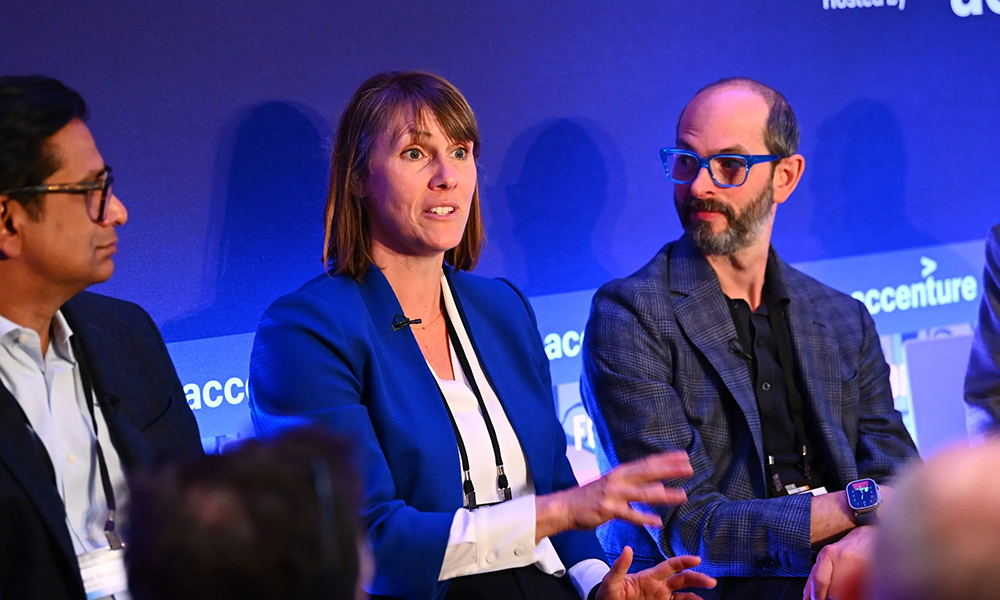
人工智能,尤其是生成式人工智能,只要得到實際應用,就能成為提高辦公效率的強大工具。
問題在于上班族們過于恐懼,擔心使用ChatGPT等工具自動完成越來越多他們的工作,將對他們構成威脅,而不是一種他們愿意參與的改變。
因此,人力資源咨詢公司The Red Plate的總經理蘇西·列維認為,秘訣在于如何讓員工以“結構化和有趣味的方式”參與應用人工智能。通過這種方式,員工不再將人工智能視為不會給他們帶來個人收益的工具,也不會將它視為應該害怕的對象。
在近日于倫敦召開的《財富》人工智能頭腦風暴大會上,她向與會者表示:“公司內的每一個職能部門都應該有一個人工智能趣味化團隊。”
列維分享了一個例子,一位熟人在鼓勵下嘗試使用ChatGPT寫了不少于17份績效評估。
下屬只需要按照她的指示完成工作;其他工作由人工智能生成。這種分工讓她可以專注于更有價值的任務,而不是去撰寫必要但耗時的文本。
她說道:“通過完整的參與之旅,人們開始與這些工具互動,并思考如何利用這些工具改進自己的工作。畢竟人類善于發(fā)現(xiàn)他們的工作有哪些問題。”
勞埃德銀行集團(Lloyds Banking Group)首席數(shù)據(jù)與分析官拉尼爾·波特儒相信,隨著團隊熟悉人工智能的功能,他們很快就會意識到它的好處。
例如,事實證明,與區(qū)塊鏈等分布式分類賬技術不同,人工智能在他的團隊成員中很受歡迎,區(qū)塊鏈技術仍在尋找一種有吸引力的應用。他的團隊成員會向他申請使用人工智能,而不是拒絕使用。
波特儒表示,事實證明,對于高度重復和需要大量人工操作的低風險任務,人工智能有很大的幫助,而在銀行業(yè)有大量此類任務。即使將驗證和質量保證等問題考慮在內,人工智能依舊能帶來足夠的生產力提升,使得為此付出的努力在本質上都是值得的。
不要忽視犯罪問題
他提到的一個例子是,經常需要對傳統(tǒng)IT軟件系統(tǒng)進行全面檢修,這項工作通常要交給團隊內更有經驗的軟件開發(fā)者和數(shù)據(jù)工程師來完成。
波特儒表示:“他們要查看舊代碼,然后從頭開始重新編寫,這需要漫長的時間。”而在他們開發(fā)的一款人工智能工具的幫助下,團隊重新編寫代碼的效率提高了35%至40%。他補充道:“我確信未來幾年,[銀行業(yè)]會有足夠多極低風險的機會。”
但人工智能也有一些缺點:人工智能可能助長盜竊行為,例如直接處理賬戶中的資金,甚至偽造他人的聲音欺騙身份驗證系統(tǒng)等。
不良分子肯定會利用列維的“人工智能趣味性”理念,測試他們如何用這項技術達到自己的目的。
因此,作為埃森哲(Accenture)的前領導力、多元化和員工參與負責人,列維認為每家組織在規(guī)劃和準備過程中都需要將這種情況考慮在內。
她說道:“人工智能讓這種不良行為變得更容易。我們必須考慮到人工智能被用于犯罪的可能性。”(財富中文網)
翻譯:劉進龍
審校:汪皓
人工智能,尤其是生成式人工智能,只要得到實際應用,就能成為提高辦公效率的強大工具。
問題在于上班族們過于恐懼,擔心使用ChatGPT等工具自動完成越來越多他們的工作,將對他們構成威脅,而不是一種他們愿意參與的改變。
因此,人力資源咨詢公司The Red Plate的總經理蘇西·列維認為,秘訣在于如何讓員工以“結構化和有趣味的方式”參與應用人工智能。通過這種方式,員工不再將人工智能視為不會給他們帶來個人收益的工具,也不會將它視為應該害怕的對象。
在近日于倫敦召開的《財富》人工智能頭腦風暴大會上,她向與會者表示:“公司內的每一個職能部門都應該有一個人工智能趣味化團隊。”
列維分享了一個例子,一位熟人在鼓勵下嘗試使用ChatGPT寫了不少于17份績效評估。
下屬只需要按照她的指示完成工作;其他工作由人工智能生成。這種分工讓她可以專注于更有價值的任務,而不是去撰寫必要但耗時的文本。
她說道:“通過完整的參與之旅,人們開始與這些工具互動,并思考如何利用這些工具改進自己的工作。畢竟人類善于發(fā)現(xiàn)他們的工作有哪些問題。”
勞埃德銀行集團(Lloyds Banking Group)首席數(shù)據(jù)與分析官拉尼爾·波特儒相信,隨著團隊熟悉人工智能的功能,他們很快就會意識到它的好處。
例如,事實證明,與區(qū)塊鏈等分布式分類賬技術不同,人工智能在他的團隊成員中很受歡迎,區(qū)塊鏈技術仍在尋找一種有吸引力的應用。他的團隊成員會向他申請使用人工智能,而不是拒絕使用。
波特儒表示,事實證明,對于高度重復和需要大量人工操作的低風險任務,人工智能有很大的幫助,而在銀行業(yè)有大量此類任務。即使將驗證和質量保證等問題考慮在內,人工智能依舊能帶來足夠的生產力提升,使得為此付出的努力在本質上都是值得的。
不要忽視犯罪問題
他提到的一個例子是,經常需要對傳統(tǒng)IT軟件系統(tǒng)進行全面檢修,這項工作通常要交給團隊內更有經驗的軟件開發(fā)者和數(shù)據(jù)工程師來完成。
波特儒表示:“他們要查看舊代碼,然后從頭開始重新編寫,這需要漫長的時間。”而在他們開發(fā)的一款人工智能工具的幫助下,團隊重新編寫代碼的效率提高了35%至40%。他補充道:“我確信未來幾年,[銀行業(yè)]會有足夠多極低風險的機會。”
但人工智能也有一些缺點:人工智能可能助長盜竊行為,例如直接處理賬戶中的資金,甚至偽造他人的聲音欺騙身份驗證系統(tǒng)等。
不良分子肯定會利用列維的“人工智能趣味性”理念,測試他們如何用這項技術達到自己的目的。
因此,作為埃森哲(Accenture)的前領導力、多元化和員工參與負責人,列維認為每家組織在規(guī)劃和準備過程中都需要將這種情況考慮在內。
她說道:“人工智能讓這種不良行為變得更容易。我們必須考慮到人工智能被用于犯罪的可能性。”(財富中文網)
翻譯:劉進龍
審校:汪皓
Artificial intelligence—and generative AI, in particular—can be powerful instruments to boost office productivity, so long as people actually use them.
The problem is there’s been so much fear mongering that workers feel the use of tools like ChatGPT to automate more and more of their job is a danger visited upon them, rather than a change they want to participate in.
That’s why Suzy Levy, managing director of human resources consultancy The Red Plate, believes the secret is figuring out how to engage workforces in a “structured and playful way.” With this approach, employees don’t see AI as a tool that offers no personal benefit to them—or as something they should outright fear.
“Every single function in an organization needs to have an AI playfulness team,” she told participants at the Fortune Brainstorm AI conference in London this week.
Levy recalled an instance where an acquaintance had written no fewer than 17 performance reviews with the help of ChatGPT after being encouraged to experiment with it.
What her subordinates needed to work on came from her own prompts; the rest came from AI. This division of labor allowed her to devote attention to tasks more valuable than crafting the requisite but time-consuming text around them.
“There is an entire engagement journey to get people to start interacting with these tools and thinking about how they can make their job better,” she said. “Because humans are experts at knowing where their jobs are terrible.”
Ranil Boteju, chief data and analytics officer at Lloyds Banking Group, was confident teams would soon realize the benefits of AI once they became familiar with its abilities.
Unlike, for example, distributed ledgers like the blockchain—technologies in search of a compelling application—AI was proving popular among his team members. They would come to him with a request to use AI rather than vice versa.
In particular, it was proving enormously helpful with very low-risk tasks that are highly repetitive and highly manual—something of which there is plenty in banking, according to Boteju. Even when validation and quality assurance is factored in, there are still enough productivity gains to make it intrinsically worth the effort.
Don’t forget the criminal element
One example he cited was the frequent job of overhauling legacy IT software systems that often fell to even the more experienced software developers and data engineers on his team.
“They would have to look at the old code and rewrite it from scratch, and that would just take forever,” Boteju said. Once they developed an AI tool to help, the team experienced a 35% to 40% efficiency improvement in their code rewriting. “I’m quite confident for the next few years there are enough very low-risk opportunities [in banking],” he added.
There are pitfalls, though: AI can facilitate theft, whether it’s directly handling money in an account or even a person’s voice in order to circumvent authentication safeguards.
Bad actors will certainly embrace Levy’s concept of “AI playfulness” to test out just how far they can use the technology to accomplish their goals.
A former head of leadership, diversity, and employee engagement at Accenture, Levy argued every organization will therefore need to factor this into their planning and preparation.
“AI makes doing dodgy things easier,” she said. “We have to insert an element of criminality in our thinking.”






